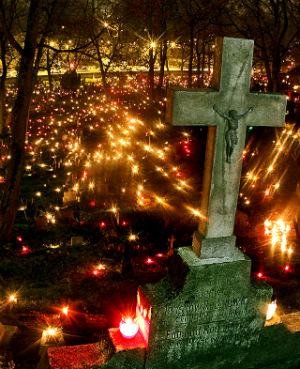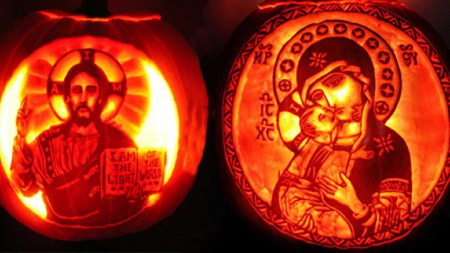Flabellum
FREE Catholic Classes
The flabellum, in liturgical use, is a fan made of leather, silk, parchment, or feathers intended to keep away insects from the Sacred Species and from the priest. It was in use in the sacrifices of the heathens and in the Christian Church from very early days, for in the Apostolic Constitutions , a work of the fourth century, we read (VIII, 12): "Let two of the deacons, on each side of the altar, hold a fan, made up of thin membranes, or of the feathers of the peacock, or of fine cloth, and let them silently drive away the small animals that fly about, that they may not come near to the cups". Its use was continued in the Latin Church to about the fourteenth century. In the Greek Church to the present day, the deacon, at his ordination, receives the hagion ripidion , or sacred fan, which is generally made to the likeness of a cherub's six-winged face, and in the sacrifice of the Mass he waves it gently over the species from the time of the Offertory to the Communion — in the Liturgy of St. Basil only during the Consecration. Among the ornaments found belonging to the church of St. Riquier, in Ponthieu (813), there is a silver flabellum ( Migne, P. L., CLXXIV, 1257), and for the chapel of Cisoin, near Lisle, another flabellum of silver is noted in the will of Everard (died 937), the founder of that abbey. When, in 1777, Martène wrote his "Voyage Littéraire", the Abbey of Tournus, on the Saône in France, possessed an old flabellum, which had an ivory handle two feet long, and was beautifully carved; the two sides of the ivory circular disc were engraved with fourteen figures of saints. Pieces of this fan, dating from the eighth century, are in the Musée Cluny at Paris, and in the Collection Carrand. The circular disc is also found in the Slavic flabellum of the thirteenth century, preserved at Moscow, and in the one shown in the Megaspileon monastery in Greece. On this latter disc are carved the Madonna and Child and it is encircled by eight medallions containing the images of cherubim and of the Four Evangelists. The inventory, taken in 1222, of the treasury of Salisbury, enumerates a silver fan and two of parchment. The richest and most beautiful specimen is the flabellum of the thirteenth century in the Abbey of Kremsmünster in Upper Austria. It has the shape of a Greek cross and is ornamented with fretwork and the representation of the Resurrection of Our Lord. A kind of fan with a hoop of little bells is used by the Maronites and other Orientals and is generally made of silver or brass.
Apart from the foregoing liturgical uses, a flabellum, in the shape of a fan, later of an umbrella or canopy, was used as a mark of honour for bishops and princes. Two fans of this kind are used at the Vatican whenever the pope is carried in state on the sedia gestatoria to or from the altar or audience-chamber. Through the influence of Count Ditalmo di Brozza, the fans formerly used at the Vatican were, in 1902, presented to Mrs. Joseph Drexel of Philadelphia, U. S. A., by Leo XIII, and in return she gave a new pair to the Vatican. The old ones are exhibited in the museum of the University of Pennsylvania. They are splendid creations. The spread is formed of great ostrich plumes tipped with peacock feathers; on the sticks are the papal arms, worked in a crimson field in heavy gold, the crown studded with rubies and emeralds. St. Paul's Cathedral, London, had a fan made of peacock feathers, and York Cathedral's inventory mentions a silver handle of a fan, which was gilded and had upon it the enamelled picture of the bishop. Haymo, Bishop of Rochester (died 1352), gave to his church a fan of silver with an ivory handle.
Join the Movement
When you sign up below, you don't just join an email list - you're joining an entire movement for Free world class Catholic education.
-

-
Mysteries of the Rosary
-
St. Faustina Kowalska
-
Litany of the Blessed Virgin Mary
-
Saint of the Day for Wednesday, Oct 4th, 2023
-
Popular Saints
-
St. Francis of Assisi
-
Bible
-
Female / Women Saints
-
7 Morning Prayers you need to get your day started with God
-
Litany of the Blessed Virgin Mary
All Saints' Day, Halloween and All Souls' Day: What's the difference?
-

Should Christians Celebrate Halloween?
-

Since when did Halloween become a Christian holiday?
-
ADORABLE: A Little Boy's Heartfelt Lunchtime Prayer
-
Scientists Decode 3,000-Year-Old Babylonian Tablet, Revealing Potential Location of Noah's Ark
Daily Catholic
 Daily Readings for Friday, November 01, 2024
Daily Readings for Friday, November 01, 2024 St. Valentine Berrio-Ochoa: Saint of the Day for Friday, November 01, 2024
St. Valentine Berrio-Ochoa: Saint of the Day for Friday, November 01, 2024 Litany of the Saints: Prayer of the Day for Friday, November 01, 2024
Litany of the Saints: Prayer of the Day for Friday, November 01, 2024- Daily Readings for Thursday, October 31, 2024
- St. Wolfgang: Saint of the Day for Thursday, October 31, 2024
- Memorare: Prayer of the Day for Thursday, October 31, 2024
![]()
Copyright 2024 Catholic Online. All materials contained on this site, whether written, audible or visual are the exclusive property of Catholic Online and are protected under U.S. and International copyright laws, © Copyright 2024 Catholic Online. Any unauthorized use, without prior written consent of Catholic Online is strictly forbidden and prohibited.
Catholic Online is a Project of Your Catholic Voice Foundation, a Not-for-Profit Corporation. Your Catholic Voice Foundation has been granted a recognition of tax exemption under Section 501(c)(3) of the Internal Revenue Code. Federal Tax Identification Number: 81-0596847. Your gift is tax-deductible as allowed by law.






 Daily Readings for Friday, November 01, 2024
Daily Readings for Friday, November 01, 2024 St. Valentine Berrio-Ochoa: Saint of the Day for Friday, November 01, 2024
St. Valentine Berrio-Ochoa: Saint of the Day for Friday, November 01, 2024 Litany of the Saints: Prayer of the Day for Friday, November 01, 2024
Litany of the Saints: Prayer of the Day for Friday, November 01, 2024

